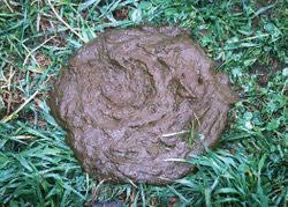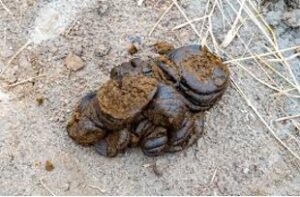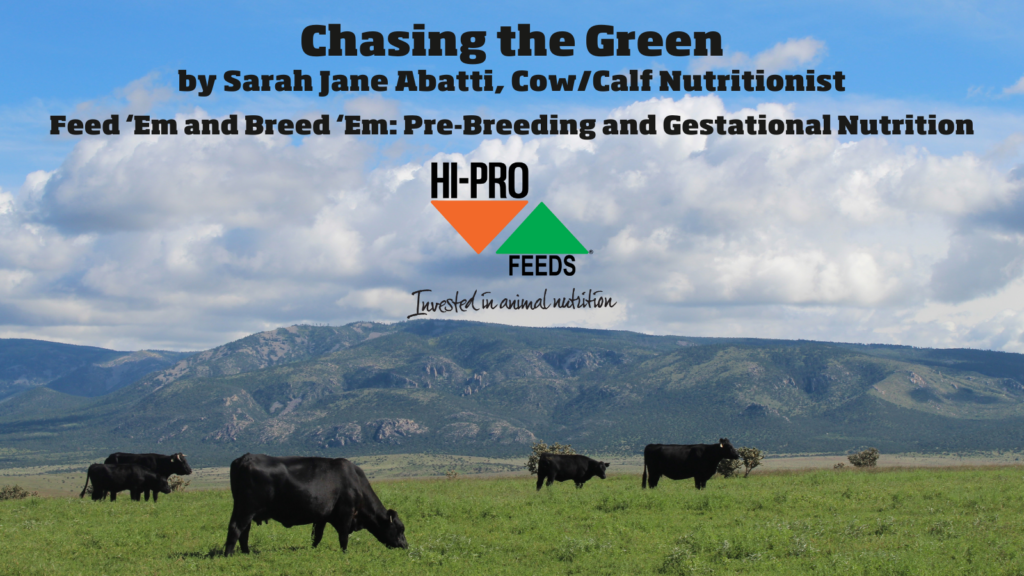Reproductive success is the cornerstone of a profitable beef operation. The first goal of any operation is always putting as many live calves on the ground as possible. The ability to efficiently breed and calve your cows maximizes your calf crop to ensure a steady supply of replacement heifers with increased herd longevity and healthy steers that succeed in the feedyard. In this guide, we’ll delve into the key aspects of nutrition that can enhance reproductive performance in your herd and set the stage for a successful calving season.
The Importance of Body Condition Score (BCS):
Body condition score (BCS) is the critical indicator of a cow’s nutritional status and overall health. Maintaining appropriate BCS throughout the production cycle is fundamental for reproductive success. The BCS scale ranges from 1 (extremely emaciated) to 9 (obese), with the ideal range for breeding cows falling between 5 and 6. The difference between any two body condition scores is generally regarded as 100 lbs. Cows with a BCS below 4.5 may experience delayed estrus cycles and reduced conception rates. Conversely, cows with a BCS above 7 may encounter difficulties during calving and may have lower fertility rates. As we head into the cold of winter, know that it is more economic to stay ahead of falling body condition scores than to fall behind; playing catch up is expensive, especially for spring calving herds.
Fecal Scoring and Monitoring:
One of the methods we can use to stay ahead of falling BCS’s is to monitor the feces. Fecal scoring allows for the real time interpretation of diet quality.
A score of 1 is a pie that is loose and does not retain any structure.

A score two, which is ideal, retains the shape of a thick pancake.

A score of 3 is a pile that is “stacked” and has several layers, resembling what has been described as a three-layer cake, a sand castle, or a mound.

When more than half of the fresh feces around a water trough are stacked (score 3), it’s time to begin or increase supplementation. Using a high-traffic area like a water trough offers a better representation of the entire herd and applying the “more than half” rule allows you to cater to the herd’s average needs. Increases in cube supplementation should be made at 1 lbs/hd/day increments for a week at a time until less than half of pies are stacking. This does not mean feeding every day. It equates to an increase in 7 lbs/hd/week and spread out over your regular feedings.
Follow this link to an article in the Texas Grazing Land Coalition newsletter for a more in depth conversation about fecal scoring.
Minerals and Vitamins for Reproductive Health:
The pre-breeding period is a critical phase when it comes to preparing cows for breeding season success and an adequate BCS is not enough to ensure an optimal breed up. A balanced mineral supplement, especially one containing essential trace minerals like copper and zinc, is crucial to support the development of healthy follicles and maintain regular estrus cycles. A copper deficiency can lead to delayed conception and embryonic loss. Zinc plays a crucial role in reproductive hormone synthesis and is essential for embryo development.
In addition to trace minerals, certain vitamins also play a pivotal role in reproductive health. Vitamin A, for instance, is essential for maintaining the integrity of reproductive organs and regulating estrus cycles. Vitamin E and selenium are powerful antioxidants that protect reproductive tissues and enhance fertility. Providing a well-balanced mineral and vitamin supplement tailored to your specific herd’s needs can greatly impact reproductive performance, ensuring healthier cows and more robust calf crops.
Fall Calving Herds in December:
During pregnancy, the nutritional requirements of the cow increase to support fetal growth and development. Our fall calving herds have the highest requirements of all in December. They are lactating and trying to get pregnant, all while combatting the cold temperatures. Energy deficiencies are four times more common than protein deficiencies across the same ranch and they require more feed to correct than protein deficiencies. Most of the time, we are correcting our protein deficiency en route to correcting an energy deficiency. For example, if the cattle require 3 lbs/hd/day of a 20% CP Cube to maintain their current body condition, it likely only took 0.75 lbs of feed to correct their protein deficiency. The other 2.25 lbs of feed are needed to correct the energy deficiency due to the decrease fiber digestibility of the grass.
For breeding phase cattle, it is recommended to feed them on a positive plane of nutrition. This means feeding them just above maintenance, allowing for a slight weight gain (~0.10 lbs/hd/day gain). This is about an extra 1.0 lbs/hd/day increase over your maintenance feeding rate. A cow’s first priority is to stay alive. Her second priority is to keep her calf on the ground alive. Her last priority is to get pregnant. A positive plane diet tells her that she has more than enough to meet her first two priorities and promotes the body to generate and retain a new pregnancy.
Spring Calving Herds in December:
Maintaining a proper BCS throughout gestation is vital to prevent complications during calving and ensure a healthy calf at birth. Late pregnancy, specifically the last 60 days before calving, is a crucial period. For pregnant cattle that are in adequate body condition, it is recommended to feed them for maintenance. Weight loss during pregnancy can negatively affect the fetus. Studies have shown that fetal protein deficiencies can have negative lifelong consequences for steer and heifer calves alike. Going into the calving season, we want to see our BCS at 5.5. These cattle should have a little more cover on them due to the weight loss they will experience immediately following calving. Because the nature of lactation is sudden, the overnight increase in energy and protein requirements is often met using the cow’s stored energy reserves, thus the decline in body condition. Please understand that this is normal; we anticipate and compensate for this effect.
Proper nutrition during late gestation also ensures calves are born with adequate stores of other essential nutrients, such as copper. Studies have also shown that a fetal copper deficiency during the first trimester can negatively affect the future health and reproductive abilities of that calf. Copper is also not available to the calf through milk, thus, the copper that the calf is born with is the only copper reserve it has until it is weaned.
You hold the key to a thriving beef operation, and optimal reproductive success is at the heart of it all. By prioritizing nutrition and carefully managing body condition score, you can set the stage for a successful calving season and maximize your calf crop. The right balance of energy, protein, minerals, and vitamins throughout the production cycle ensures healthy cows and robust calves. Embrace the power of added trace minerals in enhancing reproductive performance and watch your herd flourish with healthy calves.


